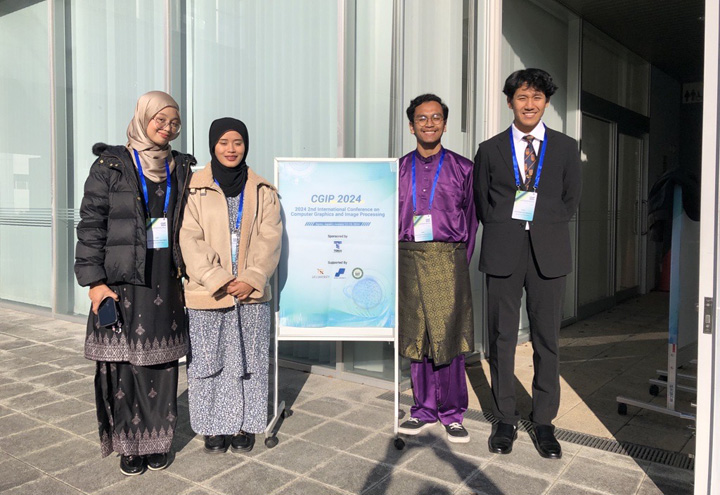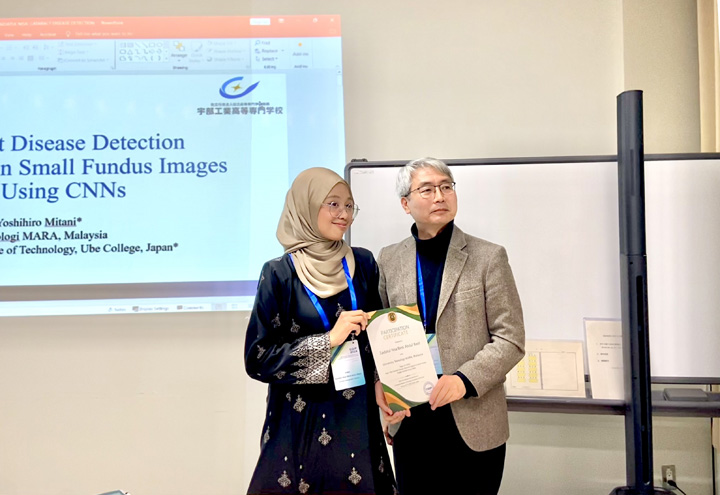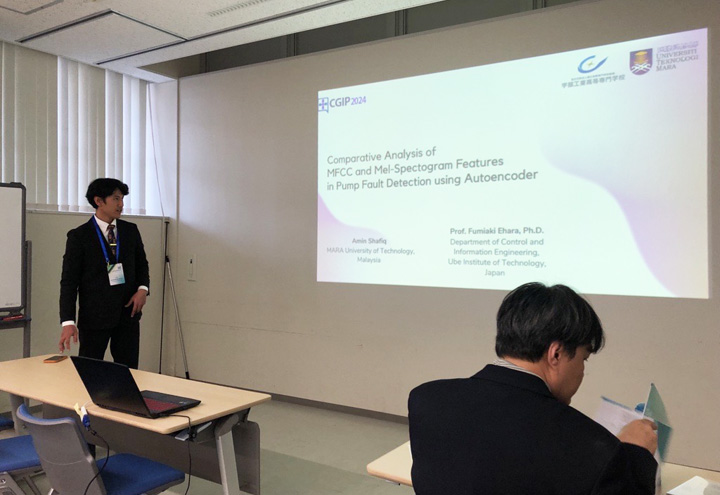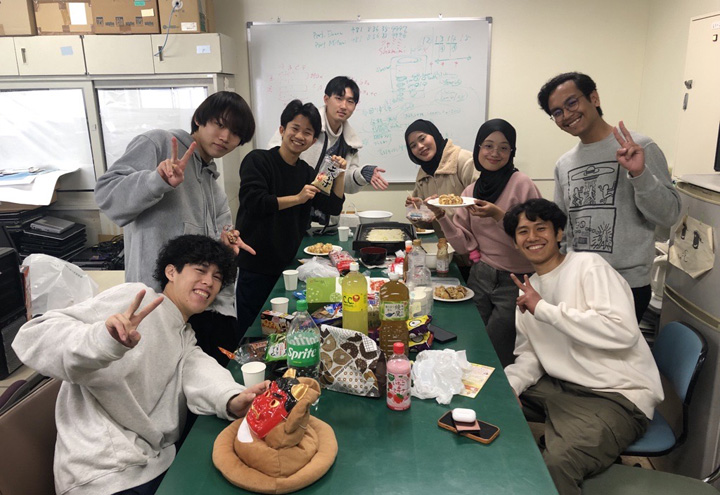2024.01.23
Các sinh viên đã tóm tắt kết quả nghiên cứu thành bài viết trong thời gian ngắn, chỉ khoảng 3 tháng. Bài nghiên cứu của cả 4 em đều được chọn lựa, mang đến cơ hội cho các em thuyết trình về nghiên cứu của mình tại Hội nghị.

Cơ sở Uji của Đại học Kyoto(Từ trái sang phải: Nisa, Intan, Shahir, Amin) |

Nisa nhận Giấy chứng nhận tham gia Hội nghị |
Tại Hội nghị, các câu hỏi từ các chuyên gia đã nêu bật lên các vấn đề trong tương lai, làm tăng cao động lực, mong muốn thực hiện các nghiên cứu sâu hơn. Bốn sinh viên cũng nói rằng, một trong các động lực khiến các em thực hiện nghiên cứu ở Ube KOSEN là nhờ vào các chia sẻ kinh nghiệm của Faiz – một sinh viên trao đổi ngắn hạn năm ngoái. Trên cơ sở, những trải nghiệm và bài học có được từ hội nghị quốc tế lần này, hy vọng rằng các em sẽ có những hoạt động mang tầm quốc tế trong tương lai.

Bài trình bày của Amin |

Hoạt động giao lưu trong phòng nghiên cứu |
Cảm nghĩ khi tham gia Hội nghị quốc tế CGIP2024
Intan
The title of my study is “Detection of Respiratory Diseases using VGG16 with Data Augmentation.” Lung disease, ranking third globally for causes of death with over 3 million annual fatalities according to the 2015 World Health Organization (WHO), underscores the significance of lung sound features in respiratory illness diagnosis. Auscultation, a subjective early detection method, led to the development of a Computer-Aided Diagnosis (CAD) system employing the VGG16 model for medical imaging complexity. Data limitations necessitated augmentation, enhancing VGG16’s performance compared to non-augment results. Respiratory Disease Detection (RDD) task was introduced. Short-Time Fourier Transform (STFT) facilitated audio feature extraction, while VGG16, using transfer learning and fine-tuning, proved effective on a Kaggle-sourced dataset. Augmentation techniques, including pitch shifting, time stretching, and horizontal flipping, addressed class imbalance. The study introduces innovative data augmentation techniques to overcome the challenge of limited training data, demonstrating the effectiveness of augmentation in enhancing the VGG16 model’s performance.
The International Conference of Computer Graphics and Image Processing 2024 exceeded my expectations. The lead-up had already sparked my excitement, and the event itself provided a wealth of knowledge through insightful presentations and valuable networking sessions. The experience left a lasting impact, offering new ideas and connections that have proven to be invaluable. The lessons learned have seamlessly integrated into my work and studies in computer graphics and image processing, shaping my approach. Beyond the conference days, its influence persists, guiding my ongoing efforts, presenting opportunities for collaboration, and fostering connections within the dynamic field. The conference has become a pivotal moment, continuously shaping and enriching my professional journey in intelligent systems engineering.
Amin
My research involved a comparative analysis of Mel-Frequency Cepstral Coefficients (MFCC) and Mel-Spectrogram for detecting faults in pump operations using an autoencoder model to enhance acoustics understanding in data science. The study, focusing on early anomaly detection, utilised audio signal processing techniques, revealing that Mel-Spectrogram significantly outperformed MFCC in various metrics.
After participating in the international conference, my overall impression of the conference was overwhelmingly positive. It was a well-organized event, full of engaging presentations and discussions. I think the conference helped to expose a student like me to new and latest information about AI field. The keynote speakers’ talk had opened my eyes to the applications of AI in fields outside of my own. This broadened my understanding and appreciation of machine learning. Moreover, the participants presentations were very insightful as there were many theories that I have never learned. Therefore, it motivates me to learn more about machine learning to stay updated in the field. Networking was another vital aspect of the conference, providing a platform for exchanging idea. I had a particularly engaging interaction with a student from Tokyo University, discussing our presentations and the field of machine learning. In conclusion, I think the international conference was more than an event. It was a platform of ideas and a bridge, linking researchers with the global community. This experience of participating in the conference has enriched my understanding and deepened my passion for AI and machine learning in industrial applications. Reflecting on the conference, I am grateful for the opportunity and excited about the future of AI and machine learning in industrial applications. Thank you.
Shahir
The title of my research is “Skin Cancer Prediction Using Convolutional Neural Network”. In a brief explanation, the study is to classify skin lesion images to be either benign or malignant using a machine learning method called Convolutional Neural Network (CNN). The title of this research was chosen to address the rising cases of skin cancer in the past years. This study aimed to explore the impact of various image size and perspective transformation as an image augmentation technique on CNN performance. The image size 64×64 had the highest accuracy of 82.51% compared to others. The best result for the augmentation is when k-range is 8 and number of augmented images is 20 with an accuracy of 83.91%. Perspective transformation was proven to improve the CNN performance.
This international conference had gave me a valuable experience and memory as it is my first time in joining this event. I am able to gain new knowledges in the field of machine learning and excited to apply them in the future. I am also grateful to Professor Yoshihiro Mitani to help and allow me to present my study there. Overall, the conference experience is really enjoyable and meaningful for my academic and future works. I am hoping to be able to publish another research paper and join another conference in the future.
Nisa
I am Zaidatul Nisa from the University Teknologi MARA, Malaysia, have presented my research paper at the International Conference on Computer Graphics and Image Processing (CGIP 2024) in Kyoto, Japan. My paper title is Cataract Disease Detection Based on Small Fundus Images Dataset Using CNNs. Cataracts are a significant global health concern, particularly among the elderly population. A cataract is an eye condition characterized by the accumulation of fluid in the lens, resulting in cloudiness and blurred vision. Therefore, the development of computer-aided diagnosis (CAD) systems is required to classify cataracts. In this paper, we proposed a convolutional neural network (CNN) model and Visual Geometry Group (VGG 19) for cataract detection in the eyes. Cataract disease detection is framed as a binary classification problem: normal and cataracts. This study explored the generalization performance of the CNN and VGG 19 for cataract classification.
The experience of participating in the international conference not only fueled my academic enthusiasm but also had a profound impact on my career development and personal growth. Prof. Mitani’s mentorship guided me in successfully presenting my research in Kyoto, leading to valuable feedback and networking opportunities. This exposure not only enhanced my research skills but also ignited a passion for continuous learning. This conference has significantly shaped my career path and continues to contribute to my ongoing journey of self-improvement and development.